Hops in Beer Brewing: Willow Creek
Published: July 27, 2025 at 7:02:30 PM UTC
Beer brewing is an art that involves experimenting with various hop varieties to create unique flavors. One such distinctive variety is the wild-grown Willow Creek hops from Colorado, known for their distinct characteristics. These hops, part of the Neomexicanus family, offer brewers a chance to explore new brewing techniques. Their unique flavor profile makes them an exciting addition to various beer recipes.
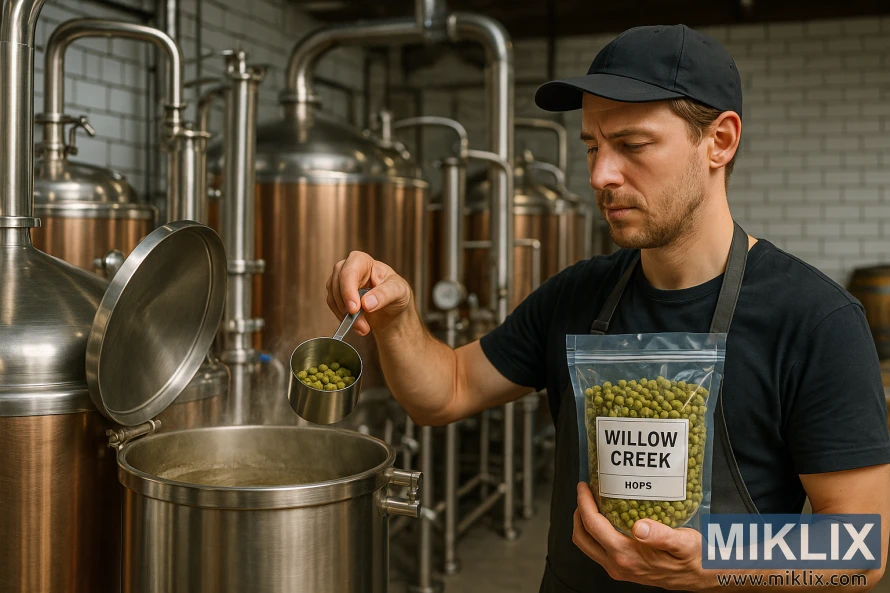
Key Takeaways
- Wild-grown hops from Colorado offer a distinct flavor profile.
- These hops are part of the Neomexicanus family.
- Experimenting with new hop varieties can enhance beer brewing.
- Brewing techniques can be refined using unique hop characteristics.
- Using different hop varieties can result in unique beer flavors.
Introduction to Willow Creek Hops
Originating from the Neomexicanus family, Willow Creek Hops introduce a new dimension to beer brewing. The Neomexicanus family is renowned for its unique traits. Willow Creek Hops stand out, providing brewers with a chance to explore new flavors.
Willow Creek Hops are celebrated for their mild yet appealing fruit flavors. They offer a strong presence of pineapple and citrus hints. This distinct flavor profile makes them a sought-after choice for brewers aiming to add a unique twist to their beers. The history of Willow Creek Hops is deeply rooted in hop breeding and selection. Farmers and brewers have worked together to develop varieties that cater to the evolving needs of the brewing industry.
The characteristics of Willow Creek Hops can be attributed to their membership in the Neomexicanus hop family. This family is celebrated for its flavor and aroma contributions in brewing. By understanding the characteristics of Willow Creek Hops, brewers can better utilize them in their recipes. This helps achieve the desired flavor profiles.
- Unique flavor profile with notes of pineapple and citrus
- Membership in the Neomexicanus hop family
- Potential for adding a new dimension to beer brewing
The Unique Profile of Willow Creek Varieties
Willow Creek Hops bring a refreshing twist to brewing with their tropical fruit and citrus notes. These hops are celebrated for their strong tropical fruit flavors and soft citrus hints. They are a go-to choice for brewers aiming to craft unique beer styles.
The distinct character of Willow Creek Hops stems from their unique chemical makeup. This is explored in depth later. Their aroma profiles, marked by refreshing and tropical notes, add a unique dimension to various beer styles.
Willow Creek Hops can be used in multiple ways to boost beer's flavor and aroma. Common methods include:
- Using them for bittering to introduce a unique bitterness to the beer.
- Incorporating them during the boil to enhance the beer's flavor and aroma.
- Dry hopping with Willow Creek Hops to refine the beer's aroma.
These hops' versatility makes them ideal for a variety of beer styles, from IPAs to pale ales. Their distinct flavor and aroma profiles empower brewers to explore new and creative beer recipes.
Chemical Composition and Brewing Properties
Willow Creek Hops stand out due to their unique chemical makeup, which greatly affects their brewing capabilities. The alpha acid content, at 6.9%, is key in determining their bittering power. This makes them ideal for a wide range of beer styles, adding a balanced bitterness.
Their chemical composition grants Willow Creek Hops versatility in brewing. Their balanced alpha acid content ensures a smooth bitterness. This complements the flavors of various beers, making them a go-to choice for brewers.
Willow Creek Hops contribute a bitterness that is neither too strong nor too weak. This makes them perfect for brewers seeking a balanced flavor. Their consistent chemical composition guarantees reliable results in every brew.
Understanding the chemical composition and brewing properties of Willow Creek Hops empowers brewers. It helps them make better decisions in crafting their beer recipes. This leads to enhanced quality in their brews.
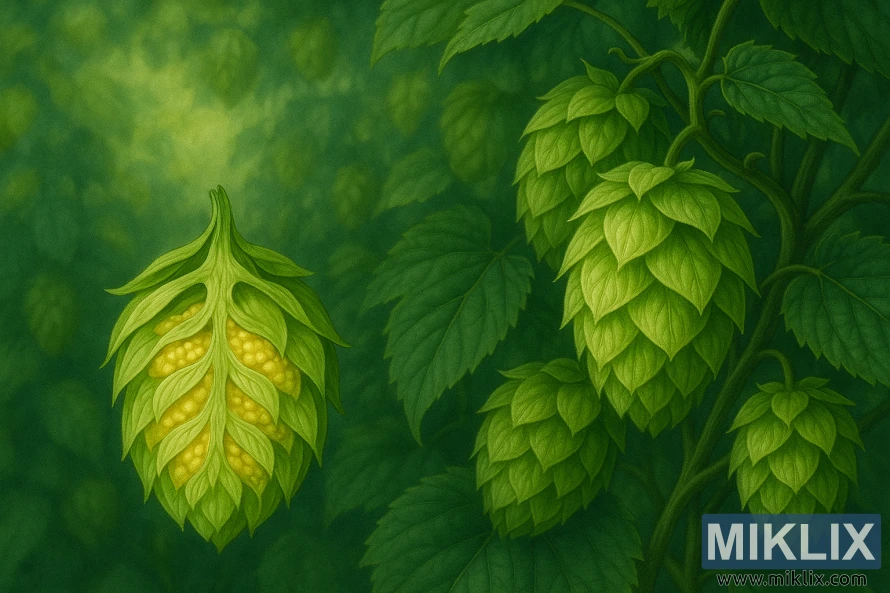
Harvesting and Processing Methods
To fully exploit Willow Creek Hops, brewers must meticulously plan their harvesting and processing. Hop vines climb trellises, with leaves unfolding and cones bursting with flavor. The timing and method of harvesting are key to retaining their distinct qualities.
The harvesting process starts when hop cones are mature and have the right moisture level. This is determined by visual checks, manual tests, and lab analysis. Best practices for harvesting Willow Creek Hops include:
- Harvesting in the early morning when moisture is highest
- Using mechanical hop pickers for efficient cone removal
- Reducing hop handling to prevent damage and maintain quality
After harvesting, hops are processed to remove excess moisture and prepare for storage or brewing. Effective methods include:
- Drying hops with heated air to lower moisture
- Compressing dried hops into bales or airtight containers
- Storing processed hops in a cool, dry place to preserve flavor and aroma
By adhering to these best practices, brewers can ensure their beers fully capture the flavor and aroma of these unique hops. Proper handling and processing are vital for maintaining hop quality from harvest to brew.
Storage and Preservation Techniques
To ensure the optimal flavor and aroma of Willow Creek Hops, it's essential to understand the best storage and preservation methods. Proper handling and storage conditions play a significant role in maintaining the freshness and quality of these hops.
Willow Creek Hops are carefully packaged in UV-blocking mylar bags, which are then vacuum-sealed to prevent exposure to oxygen and light. This packaging method is critical in preserving the delicate oils and resins found in the hops.
Cold storage is another critical aspect of preserving Willow Creek Hops. The hops are stored in a temperature-controlled environment to slow down the degradation process. Continuous temperature monitoring ensures that the storage conditions remain consistent, safeguarding the hops' freshness.
Frequent restocking is also a key practice in maintaining the quality of Willow Creek Hops. By regularly replenishing stock, brewers can ensure they are always working with the freshest hops available.
- Use UV-blocking packaging to prevent light exposure.
- Store hops in a cold, temperature-controlled environment.
- Monitor storage conditions continuously.
- Restock frequently to maintain freshness.
By adhering to these storage and preservation techniques, brewers can maximize the use of Willow Creek Hops in their brewing applications. This ensures consistent flavor and aroma profiles in their beers.
Brewing Applications and Timing
Timing is key when brewing with Willow Creek Hops. These hops shine in late boil, whirlpool, and dry hopping. This is where their tropical essence truly comes to life.
Willow Creek Hops bring a complex, fruity twist to various beer styles. Their tropical notes pair well with IPAs and pale ales. They also subtly enhance lagers and pilsners.
Late boil additions are perfect for capturing the hop's essence. Adding Willow Creek Hops in the last 15-20 minutes of boiling preserves their delicate oils. This results in a smoother bitterness.
Whirlpool additions are another effective method. By adding them to the whirlpool, brewers can extract the hop's flavor and aroma without the bitterness of boiling.
- Late boil additions for flavor and aroma
- Whirlpool additions for enhanced flavor and aroma
- Dry hopping for intense aroma
Dry hopping with Willow Creek Hops can create an intense, tropical aroma. This is a hallmark of modern IPAs. Experimenting with different dry hopping regimens is key to finding the perfect balance for your beer.
Understanding the brewing applications and timing for Willow Creek Hops unlocks their full flavor. Brewers can craft complex, flavorful beers that highlight these exceptional hops' unique characteristics.
Bittering Capacity in Various Beer Styles
Mastering the balance of bitterness and flavor is simpler with Willow Creek Hops across multiple beer styles. These hops offer a balanced bitterness, fitting well into IPAs, Pale Ales, and Wild Ales.
The bittering capability of Willow Creek Hops is a standout feature. Brewers can adjust the bitterness levels, from mild to intense, based on the beer style. For example, IPAs and Pale Ales often require a moderate to high bitterness. In contrast, Wild Ales benefit from a more subtle bitterness that enhances their complex flavors.
When using Willow Creek Hops, timing is key to balance bitterness and flavor. Early boil additions boost bitterness, while later additions add to flavor and aroma.
- In IPAs, Willow Creek Hops are ideal for both bittering and flavor additions, resulting in a balanced beer with complex hop notes.
- For Pale Ales, combining bittering and flavor hops leads to a refreshing, well-balanced brew.
- In Wild Ales, a light bitterness from Willow Creek Hops complements the beer's rich flavor profile.
Understanding Willow Creek Hops' bittering capacity and their interaction with various beer styles empowers brewers. They can craft a broad spectrum of beers, each highlighting the unique traits of these hops.
Aroma Contributions to Beer
Willow Creek Hops are known for their strong pineapple and citrus notes. These hops bring a unique aroma to a wide range of beer styles.
The aroma of Willow Creek Hops is a key reason for their popularity among brewers. They add a fruity and citrusy aroma that can enhance the character of various beers. Their distinct aroma makes them ideal for beers that need a strong, fruity scent.
Used correctly, Willow Creek Hops can add depth and complexity to beer aromas. Their pineapple and citrus notes complement many beer styles, from IPAs to pale ales.
Some key aroma characteristics of Willow Creek Hops include:
- Pineapple: A dominant fruity note that adds a tropical twist to beers.
- Citrus: Hints of citrus contribute to a bright, refreshing aroma.
- Floral notes: Subtle floral undertones that can enhance the overall aromatic complexity.
Understanding the aroma contributions of Willow Creek Hops helps brewers make informed decisions. They can use these hops to achieve the desired aromatic characteristics in their beers.
Dry Hopping with Willow Creek Hops
The art of dry hopping with Willow Creek Hops demands precision and a deep understanding of their interaction with your beer. This technique is used to boost the beer's aroma without significantly altering its bitterness.
Willow Creek Hops are celebrated for their unique tropical character. They are a top pick for brewers looking to craft beers with distinct flavors. When dry hopping with these hops, it's critical to choose the right amount. This ensures the desired aroma without overwhelming the beer.
The dry hopping process involves adding hops to the beer post-boiling, often during or after fermentation. This method allows the hops to impart their flavors and aromas into the beer. Here are some key considerations for dry hopping with Willow Creek Hops:
- Choose the right variety of Willow Creek Hops for your beer style.
- Determine the optimal amount of hops based on your desired intensity of flavor and aroma.
- Consider the timing of dry hopping, as it can impact the final character of your beer.
Brewing techniques, including dry hopping, play a significant role in shaping the final product. Exploring different hop varieties and brewing methods can help you find the perfect flavor balance in your beer.
Some recommended practices for dry hopping with Willow Creek Hops include:
- Start with a small amount (about 1-2 grams per liter) and adjust to taste.
- Monitor the beer's flavor and aroma profile during the dry hopping process.
- Keep the dry hopping process sanitary to avoid contamination.
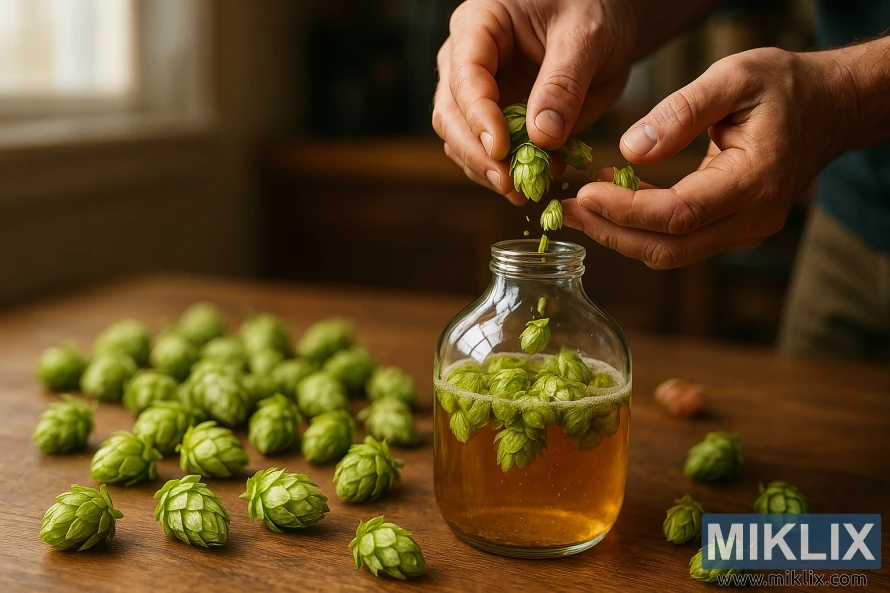
Flavor Combinations and Beer Recipes
Willow Creek Hops stand out for their unique traits, making them perfect for exploring new flavors in beer brewing. They complement other Neomexicanus varieties like Amallia, Neo1, and Multihead. This combination allows brewers to craft beers with complex hop profiles, adding depth and uniqueness.
Creating beer recipes with Willow Creek Hops opens up a world of flavor possibilities. For example, mixing them with citrus hops can yield a refreshing, vibrant beer ideal for summer. On the other hand, blending them with earthy or spicy hops can produce a robust, complex beer perfect for colder seasons.
- A Pale Ale that combines Willow Creek Hops with Amallia for a balanced citrus and floral profile.
- A Double IPA that pairs Willow Creek Hops with Neo1 for a bold, complex hop flavor.
- A Saison that uses Willow Creek Hops and Multihead to create a refreshing, spicy, and earthy beer.
Exploring different hop varieties and ratios can uncover new and exciting flavors. Willow Creek Hops' versatility makes them a key asset for brewers, opening doors to endless innovation in beer recipes.
Common Brewing Challenges and Solutions
Brewing with Willow Creek Hops comes with its own set of challenges. Brewers need to be aware of these issues and know how to troubleshoot them. This knowledge is key to achieving the desired flavor and aroma in your beer.
One major concern with whole-flower hops like Willow Creek varieties is their quick degradation after harvesting. This degradation can impact the quality and consistency of the hops. It may lead to variations in the brewing process.
To address these issues, brewers can take several steps. First, proper storage of whole-flower hops is essential to slow down degradation. Store them in a cool, dry place, away from light and oxygen.
- Use airtight containers to store hops, minimizing exposure to air.
- Keep the storage area at a consistent refrigerated temperature.
- Monitor the hops for any signs of degradation, such as changes in color or aroma.
Brewers also face the challenge of balancing bitterness, flavor, and aroma. Willow Creek Hops can enhance various beer styles. But, they require careful consideration of when and how to add them during brewing.
- For bitterness, add hops early in the boil to allow for sufficient isomerization of alpha acids.
- For flavor, add hops later in the boil or during the whirlpool to preserve delicate flavor compounds.
- For aroma, consider dry-hopping with Willow Creek Hops to impart a fresh, hoppy aroma to the beer.
By understanding these common brewing challenges and implementing the right solutions, brewers can fully leverage the unique qualities of Willow Creek Hops. This allows them to create a wide range of high-quality beers.
Quality Assessment and Selection
To brew exceptional beer, assessing the quality of Willow Creek Hops is essential. The quality of hops significantly impacts the beer's flavor, aroma, and character. This step is critical in the brewing process.
The quality of Willow Creek Hops is evaluated based on several key factors. These include alpha acid content, flavor, and aroma characteristics. Alpha acid content determines a hop's bittering power. Flavor and aroma characteristics shape the beer's overall profile.
When selecting Willow Creek Hops, brewers must consider their brewing techniques and beer styles. Different hop varieties excel in different applications. Understanding these characteristics is vital for optimal hop selection.
- Evaluate the alpha acid content to determine the hop's bittering power.
- Assess the flavor and aroma characteristics to ensure they align with the desired beer profile.
- Consider the specific brewing techniques and beer styles being produced.
By carefully evaluating the quality of Willow Creek Hops and selecting the best hops, brewers can ensure their beer meets high standards. This ensures the beer's flavor, aroma, and overall quality are exceptional.
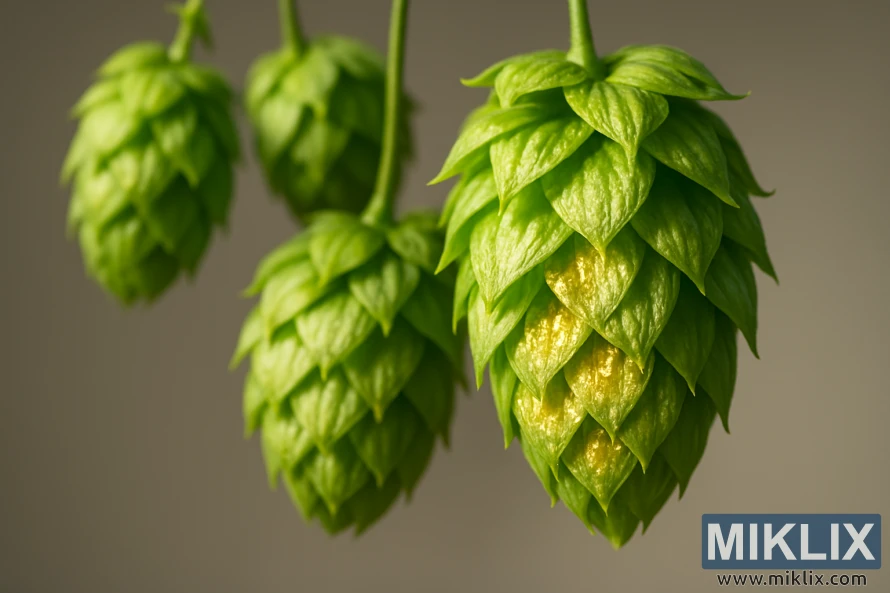
Comparing Willow Creek Hops with Other Varieties
When we compare Willow Creek Hops to other varieties, their unique brewing capabilities become clear. These hops are celebrated for their distinct flavor and aroma. This sets them apart from other hops used in brewing.
Brewers look at several factors when evaluating hop varieties. These include alpha acid content, beta acid content, and the type of essential oils present. Willow Creek Hops stand out for their balanced profile, making them suitable for a wide range of brewing applications.
Compared to other popular hops, Willow Creek Hops offer a unique combination of characteristics. For instance, they have a different alpha acid content and aroma profile compared to Cascade hops. This allows brewers to explore new flavor dimensions in their beers.
- Willow Creek Hops have a higher alpha acid content compared to some traditional aroma hops.
- Their essential oil profile contributes to a complex aroma in beer.
- Brewers can use Willow Creek Hops for both bittering and aroma purposes, depending on the brewing technique.
The comparison with other hop varieties also sheds light on the brewing techniques suitable for Willow Creek Hops. Techniques like dry hopping, late hopping, and first wort hopping can enhance their unique characteristics.
To brew with Willow Creek Hops, understanding their properties and how they interact with other ingredients is essential. By comparing them with other hop varieties, brewers can make informed decisions about their use in different beer styles.
In conclusion, comparing Willow Creek Hops with other varieties showcases their ability to create unique and complex beers. Their distinct profile and versatility make them a valuable addition to many brewers' hop inventories.
Commercial Brewing Applications
Breweries seeking to stand out are turning to Willow Creek Hops. These hops offer a unique flavor and aroma, making them perfect for creating distinct beer styles. This is a key factor in differentiating their products.
Willow Creek Hops can be used at various stages of brewing, from bittering to dry hopping. Their versatility allows brewers to experiment with different combinations. This experimentation helps achieve the desired flavor profile. For example, using them for bittering adds a subtle bitterness. Dry hopping, on the other hand, enhances the aroma.
In commercial brewing, the quality and consistency of hops are critical. Willow Creek Hops are processed and stored to preserve their unique attributes. This ensures brewers can count on consistent flavor and aroma in their beers.
Some breweries have successfully integrated Willow Creek Hops into their recipes. They've created innovative beers that attract a broad audience. As demand for unique beer styles grows, the use of Willow Creek Hops in commercial brewing is expected to increase.
Sustainable Farming Practices
Hop farming is moving towards sustainable practices to lessen its environmental footprint. These practices are vital for reducing the ecological impact of hop production. This is essential for the brewing of beer.
These methods not only conserve natural resources but also ensure the long-term sustainability of hop farming. By adopting sustainable farming, hop farmers can cut down on chemical pesticides and fertilizers. This protects local ecosystems.
Some key sustainable farming practices in hop production include:
- Using integrated pest management (IPM) techniques to minimize chemical use
- Implementing water-saving irrigation systems
- Maintaining soil health through crop rotation and organic amendments
- Promoting biodiversity around hop yards
By embracing these sustainable practices, the hop farming industry can greatly reduce its environmental impact. This ensures a steady supply of high-quality hops for beer production.
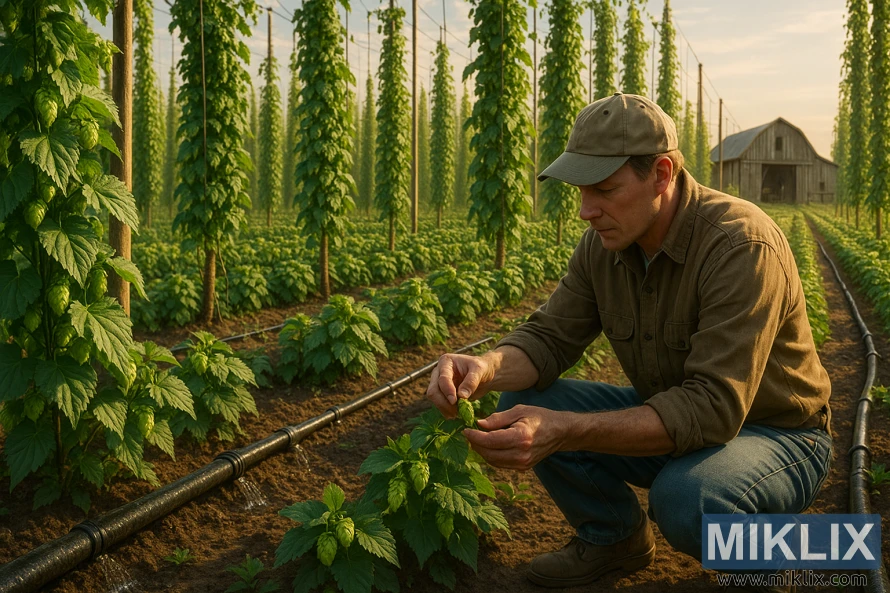
Conclusion
Willow Creek Hops have become a favorite among brewers for their unique flavor and aroma. This article has delved into their characteristics, brewing uses, and benefits. It shows how these hops can elevate beer brewing.
Key points highlight Willow Creek Hops' distinct profile, fitting various beer styles. Their chemical makeup and brewing properties were discussed. This reveals their role in adding bitterness, flavor, and aroma to beers.
In summary, brewers can use Willow Creek Hops to craft exceptional beers. By grasping their characteristics and brewing applications, brewers can innovate. This keeps them competitive in the dynamic beer brewing world.
Further Reading
If you enjoyed this post, you may also like these suggestions:
